Palette
THE EXHIBITION OF SERGEI APARIN IN MONTREUX, SWITZERLAND
Fortification in a Storm
This master and devotee, of Voronezh and Zemun, belongs to the circle of chosen ones, who personified tradition in the most contemporary forms. The living tradition, organic, not transmitted through philosophical treatises, but with skill, spirit of the craft, quiet fusion of work and dream. The Swiss audience has known him since the time he shined in the constellation of now late Etienne Chatton in the Gruyères castle. They understood the language of his paintings, the keys of which are not directly accessible. Now, twenty years later, Aparin returned to Romandy and brought surprises
By: Slobodan Despot
 It resembles a shower of meteors coming from nowhere, suddenly lighting up the sky. However, the world of Sergei Aparin was not unknown to the Swiss audience. Twenty-odd years ago, he was one of the shiniest stars in the constellation late Etienne Shatton gathered in his Museum of Fantastic Art located in the Gruyères castle. The place itself was magical, and Etienne’s fraternity elevated it to the fourth dimension, the one we perceive only in dreams. The curator-enthusiast gave his guests subjects they willingly illustrated – most often the castle itself. Thus we discovered how its medieval walls are reflected in the amazing visions of Patrick Woodroffe, Juri Siomash, Isabelle Plante and others.
It resembles a shower of meteors coming from nowhere, suddenly lighting up the sky. However, the world of Sergei Aparin was not unknown to the Swiss audience. Twenty-odd years ago, he was one of the shiniest stars in the constellation late Etienne Shatton gathered in his Museum of Fantastic Art located in the Gruyères castle. The place itself was magical, and Etienne’s fraternity elevated it to the fourth dimension, the one we perceive only in dreams. The curator-enthusiast gave his guests subjects they willingly illustrated – most often the castle itself. Thus we discovered how its medieval walls are reflected in the amazing visions of Patrick Woodroffe, Juri Siomash, Isabelle Plante and others.
 I copy.jpg) At the time, Aparin was a newly-arrived citizen of Belgrade, its suburb Zemun, to be exact, on the other side of the river. The Russian moved to Yugoslavia in the most difficult moment, in 1991, at the beginning of the forced breakdown of the country. He later formed a unique group of painters, dream hunters, with his neighbors Željko Tonšić and Mladen Đurović, in the old Austro-Hungarian town who forces people to daydream. Despite completely different styles, palettes and worlds, these three extraordinary artists built together a fortress far from the whirlpools of time. In the times of tragedies and uncertainty, as well as poverty, in which art suffers most, they defended amazing complexity and consistency. The strength of their aesthetic credo – timelessness and perfection – is certainly not unfamiliar to their long-term success. However, their fateful relation with the host of the upper chambers of the Gruyères castle should not be neglected. Ignoring cultural obstacles, worsened by the political crisis, Chatton preserved one of the rare true centers of exchange and dialogue between the east and the west of Europe.
At the time, Aparin was a newly-arrived citizen of Belgrade, its suburb Zemun, to be exact, on the other side of the river. The Russian moved to Yugoslavia in the most difficult moment, in 1991, at the beginning of the forced breakdown of the country. He later formed a unique group of painters, dream hunters, with his neighbors Željko Tonšić and Mladen Đurović, in the old Austro-Hungarian town who forces people to daydream. Despite completely different styles, palettes and worlds, these three extraordinary artists built together a fortress far from the whirlpools of time. In the times of tragedies and uncertainty, as well as poverty, in which art suffers most, they defended amazing complexity and consistency. The strength of their aesthetic credo – timelessness and perfection – is certainly not unfamiliar to their long-term success. However, their fateful relation with the host of the upper chambers of the Gruyères castle should not be neglected. Ignoring cultural obstacles, worsened by the political crisis, Chatton preserved one of the rare true centers of exchange and dialogue between the east and the west of Europe.
 II copy.jpg) Pilgrims often climbed to Gruyères at the time, to dive into the unique surrounding, the visual songs, the bath of the youth of imagination, whose gates conserved the monsters of H. R. Giger, like guards from nightmares. At the end of this paved path, behind Woodroffe’s Shield of Mars and Shield of Venus, among the massive attic beams, a circle of devotees celebrated a timeless cult, in which ancient sights mixed with diodes and gear wheels of the age of space.
Pilgrims often climbed to Gruyères at the time, to dive into the unique surrounding, the visual songs, the bath of the youth of imagination, whose gates conserved the monsters of H. R. Giger, like guards from nightmares. At the end of this paved path, behind Woodroffe’s Shield of Mars and Shield of Venus, among the massive attic beams, a circle of devotees celebrated a timeless cult, in which ancient sights mixed with diodes and gear wheels of the age of space.
Fantastic art resembled Catharism and Gruyères was its palace. This is where universal art lived, proclaimed a religious cult by some, popular art whose fame spontaneously spread among the audience. Its opponents, however, made their first task to hide the irrefutable and uncomfortable fact that the painters there, unlike many other famous contemporaries, can actually paint. They eternalized the technique of renaissance masters, showing great knowledge they refreshed the entire visual heritage of modern art, reviving the eternal symbols of our civilization. In brief, they personified tradition in the most contemporary forms. The living, organic tradition, not transferred with philosophical tractates, but with skill, spirit of the craft, silent compound of work and dream.
IN THE BRANCHES OF TIME
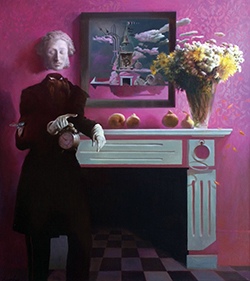 Among all those windows open towards other worlds, the precise forms and warm lights of Sergei Aparin stood out not only with their recognizable patina, but also with the atmosphere that destroyed borders between genres and smoothed his devastating virtuousness. Strange opposites united in his works: all pervaded with deep Slavic nostalgia, yet joyful, laughingly serious, tectonically airy. He carried Gruyères, as well as the entire archipelago of the old cities of Fribourg and the surrounding Heights, into a purely Aparin-like uchronia, in which these famous medieval monuments broke off from their earthly roots and sailed towards a weightless world. There’s Romont in a galley with sails and wheels. There’s Morat at night, flooded with horrible flying creatures. There’s Fribourg at dawn, crossed with a kind of a watch mechanism, on walls diving into black waters, who knows how deep. There is perhaps also the
Among all those windows open towards other worlds, the precise forms and warm lights of Sergei Aparin stood out not only with their recognizable patina, but also with the atmosphere that destroyed borders between genres and smoothed his devastating virtuousness. Strange opposites united in his works: all pervaded with deep Slavic nostalgia, yet joyful, laughingly serious, tectonically airy. He carried Gruyères, as well as the entire archipelago of the old cities of Fribourg and the surrounding Heights, into a purely Aparin-like uchronia, in which these famous medieval monuments broke off from their earthly roots and sailed towards a weightless world. There’s Romont in a galley with sails and wheels. There’s Morat at night, flooded with horrible flying creatures. There’s Fribourg at dawn, crossed with a kind of a watch mechanism, on walls diving into black waters, who knows how deep. There is perhaps also the 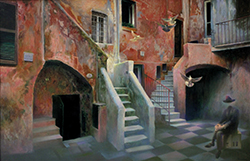 conductor of the entire phantasmagoria: the watchmaker from Zug, wearing a mask without a face and Pierrot costume, showing the city-clock to the audience.
conductor of the entire phantasmagoria: the watchmaker from Zug, wearing a mask without a face and Pierrot costume, showing the city-clock to the audience.
The river of time accompanies the mentioning of nostalgia. Time – we’ll speak about it further – is the main dimension of Aparin’s work. Time dissolves space and time reconciles opposites. It seems to me that his diptych Woman and Man in the Gruyères Castle (1997), the hybrid and unhidden homage to Flemish portraits by Van der Weyden, Van Eyck or Robert Campin, best summarizes the  Aparinian cosmogony of the time. The left hemisphere: a woman, whose ears became trees with a cow on the top of her skull. The right hemisphere: a man, serious, with a gear wheel between his fingers and the Gruyères castle on his forehead turned into a clock. On the left, Mother Nature, primordial, congenital, indolent. On the right, Man, worried, hieratic, technician and master of time. Above them – as in most of the ”Swiss” works – the inscription Loco laudato: ”cited in the approved place”, a Latin expression implying a blessing of a higher instance. Suddenly the painting becomes a fragment of a text. The Holy Testament, approved, meaning blessed… isn’t the ultimate wink addressed to God? Or the enraged demiurge, the artist himself, whom art gives infinite power? Be as it may, Aparin of the ”classic” era consciously imagines his painting as a language, whose keys are not directly accessible.
Aparinian cosmogony of the time. The left hemisphere: a woman, whose ears became trees with a cow on the top of her skull. The right hemisphere: a man, serious, with a gear wheel between his fingers and the Gruyères castle on his forehead turned into a clock. On the left, Mother Nature, primordial, congenital, indolent. On the right, Man, worried, hieratic, technician and master of time. Above them – as in most of the ”Swiss” works – the inscription Loco laudato: ”cited in the approved place”, a Latin expression implying a blessing of a higher instance. Suddenly the painting becomes a fragment of a text. The Holy Testament, approved, meaning blessed… isn’t the ultimate wink addressed to God? Or the enraged demiurge, the artist himself, whom art gives infinite power? Be as it may, Aparin of the ”classic” era consciously imagines his painting as a language, whose keys are not directly accessible.
PURIFICATION AT LAKE GENEVA
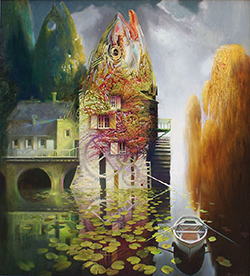 Twenty years later, Aparin returns to Romandy to write the second part of his tractate. The works exhibited in Montreux are very far from the ones we know. If it weren’t for the recognizable stroke of the brush, one would think of self-denial. Symbolism, omnipresent in the Gruyères series is almost absent in the Lavaux series or at least its most representative corpus. As if he wanted to be free from rules – including protections – of his ordinary genre, Aparin entered the daring search of the very basis of his art. The most visible testimony of it is the change of light: mystical shadows gave way to the great Provencal sun of Lake Geneva. Then comes the space: disappearance of the landscapes from dreams and entrance of recognizable geography. Finally the shocking reduction of determinants of time. The alchemist of clocks receded from the Dali-like watches and historical shortcuts. His chronological collisions now fit into the proportions of ordinary human life, the assimilation of tuberous and black silhouettes of old winegrowers into careless figures of contemporary consumer society.
Twenty years later, Aparin returns to Romandy to write the second part of his tractate. The works exhibited in Montreux are very far from the ones we know. If it weren’t for the recognizable stroke of the brush, one would think of self-denial. Symbolism, omnipresent in the Gruyères series is almost absent in the Lavaux series or at least its most representative corpus. As if he wanted to be free from rules – including protections – of his ordinary genre, Aparin entered the daring search of the very basis of his art. The most visible testimony of it is the change of light: mystical shadows gave way to the great Provencal sun of Lake Geneva. Then comes the space: disappearance of the landscapes from dreams and entrance of recognizable geography. Finally the shocking reduction of determinants of time. The alchemist of clocks receded from the Dali-like watches and historical shortcuts. His chronological collisions now fit into the proportions of ordinary human life, the assimilation of tuberous and black silhouettes of old winegrowers into careless figures of contemporary consumer society.
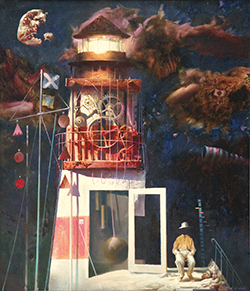 Did Aparin surrender to the Lake ”fiacca”? He wouldn’t be the first who succumbed to it. Great writer and traveler Paul Morand, who spent the last part of his life in this region, compared the landscape of Lake Geneva with the most thrilling achievements of human spirit, such as the Taj Mahal. Byron and Shelly literally defined the aesthetics of romanticism while sailing Lake Geneva, enthralled by the horrific beauty of the Alpine peaks. In his contemplation of the measure and over-measure of modern civilization, Ramuz proclaimed the area as the measure of harmonious integration between man and his environment. Recently, the saving of Lavaux vineyards from the invasion of concrete caused severe battles, into which the famous ecologist and philanthropist Franz Weber invested his body and soul, including a physical confrontation. Why was this area finally enlisted under the protection of UNESCO, although it is located in one of the most developed and most densely populated areas in the world, if not due to its obvious, original and unquestioning beauty? The beauty originates, as nowhere else, from the exemplary cooperation and balance between Mother
Did Aparin surrender to the Lake ”fiacca”? He wouldn’t be the first who succumbed to it. Great writer and traveler Paul Morand, who spent the last part of his life in this region, compared the landscape of Lake Geneva with the most thrilling achievements of human spirit, such as the Taj Mahal. Byron and Shelly literally defined the aesthetics of romanticism while sailing Lake Geneva, enthralled by the horrific beauty of the Alpine peaks. In his contemplation of the measure and over-measure of modern civilization, Ramuz proclaimed the area as the measure of harmonious integration between man and his environment. Recently, the saving of Lavaux vineyards from the invasion of concrete caused severe battles, into which the famous ecologist and philanthropist Franz Weber invested his body and soul, including a physical confrontation. Why was this area finally enlisted under the protection of UNESCO, although it is located in one of the most developed and most densely populated areas in the world, if not due to its obvious, original and unquestioning beauty? The beauty originates, as nowhere else, from the exemplary cooperation and balance between Mother  Nature and man – the architect of Time. A painter who came from afar had to be pretty audacious to dare to give his contribution to the rich iconography of Lake Geneva and Lavaux. From Bozione to Hodler, the continuous metamorphosis of the eternal, yet constantly changing waters had a hypnotic effect on the eye of artists, pushing them towards celebration of light and color. The enchanting glittering, framed with rhythmical and almost abstract shapes of the vineyard terraces and paths, disarms your mind in a way. It rocks you, so to say, into hedonism. Thus impressionist and agnostic elements growingly emerge in Aparin’s works. At the final outcome of this research, a simple shadow of leaves on a wall takes mystical sensuality and reminds of the mannerism of the Nabi school. The air and sea motifs of painters find an appropriate theater in the Lake Geneva area. Although the new geographical frame implies introducing a new palette and experimental techniques, the main subjects remain in their most subtle form. A simple strand across a water abyss is sufficient to introduce us into mystery. The vineyard paths, merged with the blueness of the sky, seem to turn the cobble into cascades: could the most reliable surfaces be merely fluid illusions? Old-time workers-wage earners dive out from the memory of a recent past, solid as rocks. A documentary processing of a black and white portrait emphasizes the cruelty of their life. They are there, very close, two generations before us, although their civilization is as alien to us as Atlantis. A simple encounter of color and black and white cause us vertigo over that abyss. Aparin no longer needs clocks or gear wheels to depict the tyranny of time.
Nature and man – the architect of Time. A painter who came from afar had to be pretty audacious to dare to give his contribution to the rich iconography of Lake Geneva and Lavaux. From Bozione to Hodler, the continuous metamorphosis of the eternal, yet constantly changing waters had a hypnotic effect on the eye of artists, pushing them towards celebration of light and color. The enchanting glittering, framed with rhythmical and almost abstract shapes of the vineyard terraces and paths, disarms your mind in a way. It rocks you, so to say, into hedonism. Thus impressionist and agnostic elements growingly emerge in Aparin’s works. At the final outcome of this research, a simple shadow of leaves on a wall takes mystical sensuality and reminds of the mannerism of the Nabi school. The air and sea motifs of painters find an appropriate theater in the Lake Geneva area. Although the new geographical frame implies introducing a new palette and experimental techniques, the main subjects remain in their most subtle form. A simple strand across a water abyss is sufficient to introduce us into mystery. The vineyard paths, merged with the blueness of the sky, seem to turn the cobble into cascades: could the most reliable surfaces be merely fluid illusions? Old-time workers-wage earners dive out from the memory of a recent past, solid as rocks. A documentary processing of a black and white portrait emphasizes the cruelty of their life. They are there, very close, two generations before us, although their civilization is as alien to us as Atlantis. A simple encounter of color and black and white cause us vertigo over that abyss. Aparin no longer needs clocks or gear wheels to depict the tyranny of time.
ART WITHOUT EPITHETS
 Progress or breakup? The answer is obvious and such obviousness helps us notice a linguistic misunderstanding. The concept of ”fantastic art”, usually related to Aparin’s works, is in fact just a pleonasm. From the moment depiction of reality implies the sight and hand of an artist, it belongs to fantastic art, whatever genre it otherwise belongs. Sergei Aparin’s Lake Geneva phase therefore more resembles maturing than reversal. It testifies about art freed from its epithets to concentrate on the essence.
Progress or breakup? The answer is obvious and such obviousness helps us notice a linguistic misunderstanding. The concept of ”fantastic art”, usually related to Aparin’s works, is in fact just a pleonasm. From the moment depiction of reality implies the sight and hand of an artist, it belongs to fantastic art, whatever genre it otherwise belongs. Sergei Aparin’s Lake Geneva phase therefore more resembles maturing than reversal. It testifies about art freed from its epithets to concentrate on the essence.
I visited Aparin once in his studio in Zemun, bathing in light. I saw sketches, variations, even white canvases waiting for the first stroke of the brush. I admired the remarkable plastic work on materials, on the subject of horse’s head. I also noticed palettes of dark shades. Then it burst before my eyes: this aerial painter levitates above his own technique and matter. Whether symbolic or empiric, oneiric or naturalistic, his work is an expression of a wondrous gift and rare ideal. Whatever he does in the future, Aparin’s eyes will always look upwards, towards great masters and towards the skies.
***
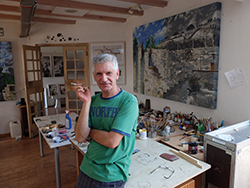 Biography
Biography
Sergei Aparin was born in 1961 in the Russian city of Voronezh. He graduated from the Institute of Arts in 1981 in his hometown. During the following ten years (1981-1991), he painted and exhibited at group exhibitions in St. Petersburg, Kiev and Moscow. In 1991, he moved to the capital of Serbia. He left a deep trace in contemporary Serbian painting, and gained a reputation of a great master in international proportions. He exhibited throughout Europe and in North America. More information about him and reproductions of his paintings may be found at: www.aparin.com.
